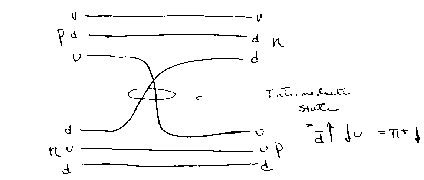The effective mass of a system, E_cm^2 = E_tot^2-p_tot^2 c^2 does not change from reference from to reference frame. This mass is, obviously, the center of mass energy, or the energy available to make new particles. For part A of this problem E_cm = 4 m_p c^2 = 3.7532 GeV. For part B) E_cm = (2 m_p + 2 m_n) c^2 = 3.7557 GeV. In either case
E_tot-lab = E_beam + m_p c^2 = KE_beam + 2 m_p c^2 P_tot-lab = Sqrt[E_beam^2 - m_p^2 c^4]/c = Sqrt[(KE + m_p c^2)^2 - m_p^2 c^4]/c = Sqrt[KE^2 + 2 KE m_p c^2]/c E_cm^2 = E_lab-tot^2 - p_tot-lab^2 c^2 = KE^2 + 4 KE m_p c^2 + 4 m_p^2 c^4 - KE^2 - 2 KE m_p c^2 = 2 KE m_p c^2 + 4 m_p^2 c^4 KE = (E_cm^2 - 4 m_p^2 c^4)/(2 m_p c^2) Part A) KE = 5.63 GeV ---> p_beam = 6.50 GeV/c Part B) KE = 5.64 GeV ---> p_beam = 6.51 GeV/c
Part A) In the laboratory, E_cm is given above for one particle hitting a stationary target. Thus,
E_cm = Sqrt[2 KE m_p c^2 + 4 m_p^2 c^4] = 43.36 GeV Mass_X = (E_cm - 2 m_p c^2)/c^2 = 41.48 GeV/c^2
Part B) This is the center of mass (total momentum is zero). Thus:
E_cm = 2 KE + 2 m_p c_2 = 1001.9 GeV/c Mass_X = E_cm - 2 m_p c^2)/c^2 = 1000 GeV/c^2

Plus, what is the momentum of the pion in the lab if the initial momentum of the Lambda^0 in the lab is 15 GeV/c and the pion and proton appear in the lab on trajectories colinear with the parent particle?
Solution to book problem:
Conservations of Energy:
M_L c^2 = E_p + E_pi
Conservation of Momentum:
0 = p_p + p_pi ---> p_p = - p_pi = p
Constituent equations:
E_p = Sqrt[p^2 c^2 + m_p^2 c^4] E_pi = Sqrt[p^2 c^2 + m_pi^2 c^4]
First solve for the energy of the proton:
E_p = (m_L^2 + m_p^2 - m_pi^2)c^2/(2 m_L) = (1115.6^2 + 938.3^2 - 139.6^2)/(2 1115.6)MeV = 943.65 MeV KE_p = E_p - m_p c^2 = 5.35 MeV E_pi = (m_L^2 + m_pi^2 - m_p^2)c^2/(2 m_L) = 171.9 MeV KE_pi = E_pi - m_pi c^2 = 32.3 MeV
Solution to added part:
Equations are the same except that the momentum conservation equation equals the momentum of the lambda instead of zero and you add a constituent equation for the Lambda. The algebra gets a little messy. The solution is in a Mathematica Notebook.
Plus how far will the kaon travel if it has a momentum of 20 GeV/c? (Remember time dihilation for both of these parts!)